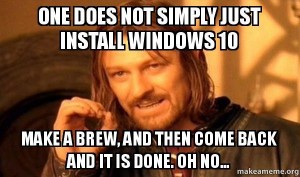
Windows 10 has been available for a month so I thought it would be fitting to use this week’s article to talk about some of the good and bad of upgrading. I will start by saying Windows 10 has been really, really good for business. All of my stores have been flooded with Windows 10 computers.
I guess starting with the good is always the best, it kind of makes the bad seem not so bad. For those coming from Windows 8, 10 puts back many of the features from previous operating systems including the start button. Aesthetically, Windows 10 is very pleasing.
Now onto some of the bad. We have a ton of stories I hear every day from customers so I could probably fill this page with crazy stuff, but I’ve decided to keep it to my 600 word limit. As you read this keep in mind fixing these issues is the nature of my business.
Although hardware issues aren’t commonplace, we’ve seen our share of Windows 10 screwing up configurations in some pretty odd ways. Just last week we upgraded a customer’s machine only to find it completely disabled the keyboard. Reloading the previous operating system didn’t fix the problem at all. Somehow the computer’s BIOS corrupted during the process.
Sometimes the BIOS modifications made by 10 totally impair the function of a computer to the point it won’t turn on. Earlier updates caused complete chaos to several systems that came through our doors. My archaic programming tool has come in handy for a few machines this month.
Windows 10 changing the hardware and making machines useless is inexcusable. The operating system shouldn’t be allowed to modify the components of a system. A keyboard that was flawless before the upgrade should still work perfect after the upgrade. Having to manually remove a chip to flash it is just silly.
Data loss seems to be a common story for some of my customers. During the upgrade process Windows 10 temporarily relocates the data to a Windows.old folder then moves it back to the original location. Sometimes during the shift, the data is simply left in the Windows.old folder and other times it vanishes.
One issue we seem to see a lot is the Windows 10 graphic interface working improperly. Sometimes buttons are nonresponsive or shortcuts don’t work. Other times the icons are out of place. Luckily the fix is relatively easy, but it means the customer will lose most of their software.
There are some common causes we’ve seen on many of the computers that come to us with Windows 10 problems. Many times the original operating system has viruses. Junk files installed on the computer need to be cleared prior to upgrading. Basically, Windows 10 defends against viruses a little differently than previous versions and doesn’t know what to do with them.
Faulty hardware seems to be the other major issue with upgrading. Because Windows 10 moves a ton of data in a short amount of time, a hard drive that was teetering becomes a giant problem during the upgrade. It seems like one bad sector can make the entire process disastrous.
I happen to really like Windows 10 and think it’s worth the upgrade from Windows 8 and 8.1. On my own computer (the one I’m on now) I made the swap a month ago and wouldn’t go back. I’m glad it worked because I don’t know where I’d get it repaired.
(Jeromy Patriquin is the President of Laptop & Computer Repair, Inc. located at 509 Main St. in Gardner. You can call him at (978) 919-8059 or visit www.LocalComputerWiz.com.)
